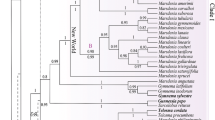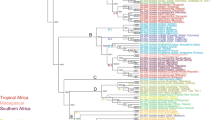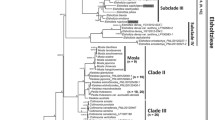Abstract
Among the 12 subfamilies currently considered in the systematics of Poaceae, the Arundinoideae have long been considered as a dustbin group, with a diversity of forms putatively hiding incertae sedis. Because this subfamily has been poorly investigated using molecular markers for the last two decades, the present study provides the first complete phylogeny of the Arundinoideae based on five plastid DNA loci sequenced for 12 genera, and analysed with and without plastome data from previous studies. The refined Arundinoideae appear to be a robust evolutionary lineage of Poaceae, divided into three tribes with some biogeographical patterns: (1) tribe Arundineae, the most heterogeneous tribe, including Eurasian Arundo, Australian Amphipogon and Monachather, and South African Dregeochloa; (2) tribe Crinipedeae (described here), including Crinipes, Elytrophorus, Styppeiochloa and Pratochloa (described here), with a South and East African distribution; and (3) tribe Molinieae, including Hakonechloa, Molinia and Phragmites, with a Eurasian distribution. Despite reduction in size, this small subfamily conserves a high diversity of morphological forms, with several small but highly differentiated genera. Finally, the molecular dating approach provides an evolutionary framework to understand the diversification of Arundinoideae, refuting Gondwanan vicariance between genera and suggesting capability for long distance dispersal.


Similar content being viewed by others
References
Auquier P (1963) Critères anciens et modernes dans la systématique des Graminées. Natura Mosana 16:1–63
Avdulov NP (1931) Karyo-systematische Untersuchungen der Familie Gramineen. Bull Appl Bot Suppl 44:1–428
Barker NP (1997) The relationships of Amphipogon, Elytrophorus and Cyperochloa (Poaceae) as suggested by rbcL sequence data. Telopea 7:205–213
Barker NP, Linder HP, Harley EH (1995) Polyphyly of Arundinoideae (Poaceae): evidence from rbcL sequence data. Syst Bot 20:423–435. doi:10.2307/2419802
Barker NP, Linder HP, Harley EH (1998) Sequences of the grass-specific insert in the chloroplast rpoC2 gene elucidate generic relationships of the Arundinoideae (Poaceae). Syst Bot 23:327–350. doi:10.2307/2419509
Barrero RA, Guerrero FD, Moolhuijzen P, Goolsby JA, Tidwell J, Bellgard SE, Bellgard MI (2015) Shoot transcriptome of the giant reed, Arundo donax. Data Brief 3:1–6. doi:10.1016/j.dib.2014.12.007
Brown R (1810) Prodromus florae Novae Hollandiae et insulae Van-Diemen. J. Johnson, London
Brown R (1814) General remarks, geographical and systematical, on the botany of Terra Australis. In: Flinders M (ed) A voyage to Terra Australis: undertaken for the purpose of completing the discovery of that vast country, and prosecuted in the years 1801, 1802, and 1803. W. Bulmer, London, pp 580–583 (appendix 3)
Christin PA, Spriggs E, Osborne CP, Strömberg CA, Salamin N, Edwards EJ (2013) Molecular dating, evolutionary rates, and the age of the grasses. Syst Biol 63:153–165. doi:10.1093/sysbio/syt072
Clark LG, Zhang W, Wendel JF (1995) A phylogeny of the grass family (Poaceae) based on ndhF sequence data. Syst Bot 20:436–460. doi:10.2307/2419803
Clayton WD, Renvoize SA (1986) Genera graminum: grasses of the world. Kew Bull Addit Ser 13:1–389
Conert HJ (1961) Die Systematik und Anatomie der Arundinae. Verlag von J. Cramer, Weinheim
Conert HJ (1966) Dregeochloa, eine neue Gattung der Gramineen (Gramineae, Arundinoideae, Danthonieae). Senckenberg Biol 47:35–43
Cotton JL, Wysocki WP, Clark LG, Kelchner SA, Pires JC, Edger PP, Mayfield-Jones D, Duvall MR (2015) Resolving deep relationships of PACMAD grasses: a phylogenomic approach. BMC Pl Biol 15:178. doi:10.1186/s12870-015-0563-9
Crisp MD, Cook LG (2013) How was the Australian flora assembled over the last 65 million years? A molecular phylogenetic perspective. Annual Rev Ecol Evol Syst 44:303–324. doi:10.1146/annurev-ecolsys-110512-135910
Darriba D, Taboada GL, Doallo R, Posada D (2012) jModelTest 2: more models, new heuristics and parallel computing. Nat Meth 9:772. doi:10.1038/nmeth.2109
Doyle JJ, Doyle JL (1987) A rapid DNA isolation procedure for small quantities of fresh leaf tissue. Phytochem Bull 19:11–15
Drummond AJ, Rambaut A (2007) BEAST: Bayesian evolutionary analysis by sampling trees. BMC Evol Biol 7:214. doi:10.1186/1471-2148-7-214
Drummond AJ, Ho SY, Phillips MJ, Rambaut A (2006) Relaxed phylogenetics and dating with confidence. PLoS Biol 4:e88. doi:10.1371/journal.pbio.0040088
Duvall MR, Morton BR (1996) Molecular phylogenetics of Poaceae: an expanded analysis of rbcL sequence data. Molec Phylogen Evol 5:352–358. doi:10.1006/mpev.1996.0030
Ellis R (1977) Leaf anatomy of the South African Danthonieae (Poaceae). I. The genus Dregeochloa. Bothalia 12:209–213
Grass Phylogeny Working Group (GPWG) (2001) Phylogeny and subfamilial classification of the grasses (Poaceae). Ann Missouri Bot Gard 88:373–457. doi:10.2307/3298585
Grass Phylogeny Working Group II (GPWG II) (2012) New grass phylogeny resolves deep evolutionary relationships and discovers C4 origins. New Phytol 193:304–312. doi:10.1111/j.1469-8137.2011.03972.x
Hilu KW, Alice LA, Liang H (1999) Phylogeny of Poaceae inferred from matK sequences. Ann Missouri Bot Gard 86:835–851. doi:10.2307/2666171
Hsiao C, Jacobs SWL, Barker NP, Chatterton NJ (1998) A molecular phylogeny of the subfamily Arundinoideae (Poaceae) based on sequences of rDNA. Austral Syst Bot 11:41–52. doi:10.1071/SB97001
Hsiao C, Jacobs SWL, Chatterton NJ, Asay KH (1999) A molecular phylogeny of the grass family (Poaceae) based on the sequences of nuclear ribosomal DNA (ITS). Austral Syst Bot 11:667–688. doi:10.1071/SB97012
Ingram AL, Christin PA, Osborne CP (2011) Molecular phylogenies disprove a hypothesized C4 reversion in Eragrostis walteri (Poaceae). Ann Bot (Oxford) 107:321–325. doi:10.1093/aob/mcq226
Isozaki Y, Aoki K, Nakama T, Yanai S (2010) New insight into a subduction-related orogen: a reappraisal of the geotectonic framework and evolution of the Japanese Islands. Gondwana Res 18:82–105
Jacques-Félix H (1958) IX - Notes sur les graminées d’Afrique tropicale. J Agric Trop Bot Appl 5:304–307
Jirásek V (1966) The systematics of cultivated plants and their taxonomic categories. Preslia 38:267–284
Jolivet L, Tamaki K, Fournier M (1994) Japan Sea, opening history and mechanism: a synthesis. J Geophys Res Solid Earth 99:22237–22259. doi:10.1029/93JB03463
Katoh K, Standley DM (2013) MAFFT multiple sequence alignment software version 7: improvements in performance and usability. Molec Biol Evol 30:772–780. doi:10.1093/molbev/mst010
Kellogg EA (2000) The grasses: a case study in macroevolution. Annual Rev Ecol Syst 31:217–238. doi:10.1146/annurev.ecolsys.31.1.217
Kellogg EA (2015) Flowering plants. Monocots: Poaceae, vol. 13. Springer, Berlin
Lambertini C, Mendelssohn IA, Gustafsson MH, Olesen B, Tenna RIIS, Sorrell BK, Brix H (2012) Tracing the origin of Gulf Coast Phragmites (Poaceae): a story of long-distance dispersal and hybridization. Amer J Bot 99:538–551. doi:10.3732/ajb.1100396
Linder HP, Verboom GA, Barker NP (1997) Phylogeny and evolution in the Crinipes group of grasses (Arundinoideae: Poaceae). Kew Bull 52:91–110. doi:10.2307/4117843
Prasad V, Strömberg CAE, Leaché AD, Samant B, Patnaik R, Tang L, Mohabey DM, Ge S, Sahni A (2011) Late Cretaceous origin of the rice tribe provides evidence for early diversification in Poaceae. Nat Commun 2:480. doi:10.1038/ncomms1482
Prat H (1932) L’épiderme des Graminées. Étude anatomique et systématique. Ann Sci Nat Bot 14:117–324
Prat H (1936) La systématique des Graminées. Ann Sci Nat Bot 18:165–258
Prat H (1960) Vers une classification naturelle des Graminées. Bull Soc Bot France 107:32–79
Rambaut A, Suchard M, Drummond A (2017) Tracer, version 1.6. Available at: http://tree.bio.ed.ac.uk/software/tracer/
Renvoize SA (1981) The sub-family Arundinoideae and its position in relation to a general classification of the Gramineae. Kew Bull 36:85–102. doi:10.2307/4119008
Saltonstall K, Peterson PM, Soreng RJ (2004) Recognition of Phragmites australis subsp. americanus (Poaceae: Arundinoideae) in North America: evidence from morphological and genetic analyses. Sida 21:683–692
Sánchez-Ken JG, Clark LG, Kellogg EA, Kay EE (2007) Reinstatement and emendation of subfamily Micrairoideae (Poaceae). Syst Bot 32:71–80. doi:10.1600/036364407780360102
Shantz HL (1954) The place of grasslands in the Earth’s cover. Ecology 35:143–145. doi:10.2307/1931110
Soreng RJ, Peterson PM, Romaschenko K, Davidse G, Zuloaga FO, Judziewicz EJ, Filgueiras TS, Davis JI, Morrone O (2015) A worldwide phylogenetic classification of the Poaceae (Gramineae). J Syst Evol 53:117–137. doi:10.1111/jse.12150
Stebbins GL, Crampton B (1959) A suggested classification of grass genera of North America based on modern criteria. Congr Int Bot 9th 2:378–379
Taira A (2001) Tectonic evolution of the Japanese island arc system. Annual Rev Earth Planet Sci 29:109–134. doi:10.1146/annurev.earth.29.1.109
Tamura K, Stecher G, Peterson D, Filipski A, Kumar S (2013) MEGA6: molecular evolutionary genetics analysis version 6.0. Molec Biol Evol 30:2725–2729. doi:10.1093/molbev/mst197
Acknowledgements
The authors thank staffs from BM, CANB, ETH, K, MARS, P, PRE and STR Herbaria for loans and material removal. LH addresses a special thanks to Pascal-Antoine Christin (University of Sheffield) for data and support in the calibration of the molecular phylogeny, and to Jordan Teisher (Washington University in St. Louis) for useful and sporting exchange views about the systematics of Arundinoideae. The authors are also grateful to Marianick Juin (IMBE) for contribution in the lab work, to Heather Lindon (RBG Kew) for expertise in botanical Latin, and to Paul M. Peterson (US, Smithsonian Institution) for his conscientious review which greatly improved the readability of the manuscript.
Author information
Authors and Affiliations
Corresponding author
Ethics declarations
Conflict of interest
The authors declare that they have no conflict of interest.
Ethical statement
The authors comply will all rules of the journal following the COPE guidelines; all authors have contributed and approved the final manuscript.
Additional information
Handling editor: Frank Blattner.
Electronic supplementary material
Below is the link to the electronic supplementary material.
Online Resource 1
Sampling information and GenBank accessions (PDF 114 kb)
Online Resource 2
Primers used in PCRs and developed for the present study (PDF 75 kb)
Online Resource 3
loci + plastome alignment used for phylogenetic analyses (NEX 6902 kb)
Information on Electronic Supplementary Material
Information on Electronic Supplementary Material
Online Resource 1. Sampling information and GenBank accessions.
Online Resource 2. Primers used in PCRs and developed for the present study.
Online Resource 3. Loci + plastome alignment used for phylogenetic analyses.
Rights and permissions
About this article
Cite this article
Hardion, L., Verlaque, R., Haan-Archipoff, G. et al. Cleaning up the grasses dustbin: systematics of the Arundinoideae subfamily (Poaceae). Plant Syst Evol 303, 1331–1339 (2017). https://doi.org/10.1007/s00606-017-1451-6
Received:
Accepted:
Published:
Issue Date:
DOI: https://doi.org/10.1007/s00606-017-1451-6




